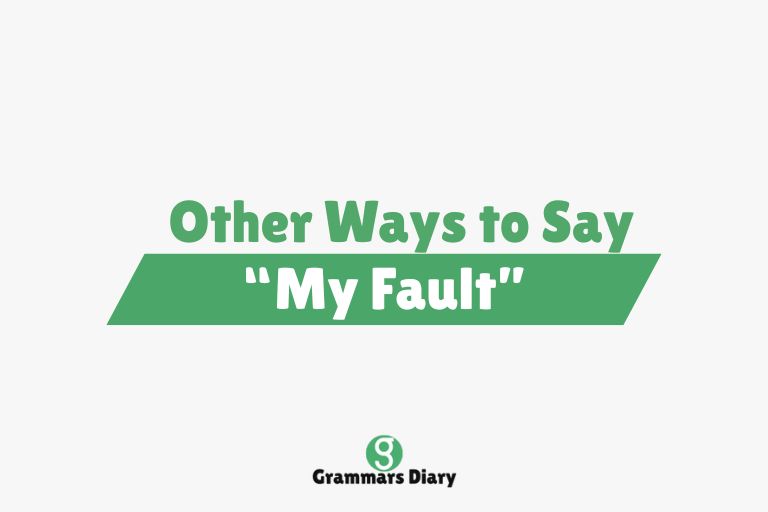The phrase “my fault” is commonly used to admit a mistake, accept blame, or acknowledge responsibility for something that went wrong. Whether in professional, casual, or deeply personal conversations, this simple expression can carry significant emotional weight. But sometimes, saying “my fault” might feel too casual, too blunt, or just not the right fit for the moment.
Thankfully, there are many thoughtful and nuanced alternatives you can use to convey accountability, depending on how formal, apologetic, or empathetic you wish to be. In this article, we’ll explore 24 different ways to say “my fault,” each explained in detail with examples and the appropriate contexts for using them—so you can express yourself clearly, confidently, and appropriately in any situation.
Other Ways to Say “My Fault”
1. My Apologies
Example: “My apologies for missing the meeting earlier.”
Meaning: A polite and formal way of expressing regret, typically used in both written and spoken communications where you want to sound respectful and accountable.
Usage: Ideal in business emails, formal interactions, or when addressing superiors.
2. I Take Full Responsibility
Example: “I take full responsibility for the delay in the report.”
Meaning: A strong statement that emphasizes complete accountability for a mistake or problem, without placing blame elsewhere.
Usage: Best used in high-stakes professional environments or serious personal admissions.
3. That Was On Me
Example: “I forgot to send the invoice—that was on me.”
Meaning: A casual and direct way to acknowledge that you were at fault.
Usage: Often used in friendly, informal settings like with coworkers or friends.
4. I Messed Up
Example: “I messed up the schedule and caused confusion.”
Meaning: A candid, slightly informal way to admit a mistake.
Usage: Works well when you want to be honest and transparent, especially in informal or mid-level professional settings.
5. I Was Wrong
Example: “I was wrong to assume it would work that way.”
Meaning: Clearly acknowledges an incorrect decision or belief and shows humility.
Usage: Suitable for both personal relationships and professional environments where you value integrity.
6. I Made a Mistake
Example: “I made a mistake in calculating the budget.”
Meaning: A straightforward, neutral admission that you did something incorrectly.
Usage: Appropriate across many contexts, from personal conversations to work settings.
7. Please Forgive Me
Example: “Please forgive me—I didn’t mean to hurt your feelings.”
Meaning: A sincere request for forgiveness, acknowledging you caused harm or offense.
Usage: Best used in emotional or personal situations when you truly regret your actions.
8. I Stand Corrected
Example: “You’re right about the figures—I stand corrected.”
Meaning: A formal way to acknowledge that someone else is right and you were mistaken.
Usage: Often used in debates, professional exchanges, or intellectual discussions.
9. That’s My Bad
Example: “I forgot to attach the file—that’s my bad.”
Meaning: A relaxed, conversational way to say you’re at fault.
Usage: Works well in casual contexts, among peers, or in text messages.
10. I Own That
Example: “Yes, the miscommunication happened—I own that.”
Meaning: A confident admission that you accept full accountability for an error.
Usage: Especially common in modern workplace culture where taking ownership is valued.
11. I Take the Blame
Example: “If the report was late, I take the blame for that.”
Meaning: Clearly identifies yourself as the person responsible for something that went wrong.
Usage: Appropriate for both formal and informal scenarios where honesty matters.
12. That’s My Responsibility
Example: “The missing documents were my responsibility.”
Meaning: Accepts ownership of a task or outcome, reinforcing your role in the error.
Usage: Useful in professional environments when reporting or explaining accountability.
13. I Should Have Known Better
Example: “I should have known better than to rely on unverified data.”
Meaning: A reflective admission that you made a mistake despite knowing or suspecting better, showing maturity and regret.
Usage: Often used in both personal and professional scenarios, especially when acknowledging poor judgment.
14. I Accept Responsibility
Example: “I accept responsibility for the error in our advertising.”
Meaning: A direct and often formal way to acknowledge fault, usually used in public statements or serious discussions.
Usage: Effective in leadership roles, business environments, or public apologies.
15. I Dropped the Ball
Example: “I dropped the ball by not following up with the client.”
Meaning: A metaphorical way of saying you failed to do something important, often casually used.
Usage: Common in workplace slang or casual team environments.
16. I Goofed
Example: “I goofed and sent the wrong version of the file.”
Meaning: A lighthearted or slightly humorous way to admit a small or non-serious mistake.
Usage: Appropriate for minor slip-ups, especially in informal or relaxed situations.
17. I Was At Fault
Example: “I was at fault for the miscommunication.”
Meaning: A formal and clear way to declare that the mistake was yours.
Usage: Suitable for legal, formal, or written apologies where clarity is crucial.
18. That’s Completely On Me
Example: “The failure to deliver on time? That’s completely on me.”
Meaning: Strongly asserts your full accountability, leaving no room for blame shifting.
Usage: Powerful in leadership, conflict resolution, and high-stakes situations.
19. I Take Ownership
Example: “I take ownership of the delay—it shouldn’t have happened.”
Meaning: Communicates responsibility and commitment to fixing the issue.
Usage: Ideal for professional growth, leadership, and problem-solving environments.
20. I Accept the Blame
Example: “I accept the blame for the oversight in the financial summary.”
Meaning: Reinforces your willingness to take the consequences of your actions.
Usage: Works well in formal business settings or written communication.
21. I Regret That
Example: “I regret that I didn’t listen to your concerns earlier.”
Meaning: Expresses sorrow about the outcome and acknowledges your part in it.
Usage: Effective in emotionally sensitive situations, especially in personal or interpersonal apologies.
22. I Was Careless
Example: “I was careless and didn’t double-check the numbers.”
Meaning: Admits that your lack of attention or diligence led to an error.
Usage: Good for showing awareness of the cause of the mistake in both personal and work settings.
23. I Shouldn’t Have Done That
Example: “I shouldn’t have ignored the warning signs.”
Meaning: A candid recognition that your action (or inaction) was incorrect or harmful.
Usage: Useful in sincere, personal discussions, especially when expressing regret.
24. I Was Negligent
Example: “I was negligent in updating the records, and that caused confusion.”
Meaning: A formal and serious term that implies a failure to meet responsibilities or duties.
Usage: Suitable in legal, corporate, or official settings where accountability must be clearly addressed.
When to Use Different “My Fault” Alternatives
In Professional Settings
In the workplace or business communications, it’s important to choose alternatives that demonstrate maturity, professionalism, and accountability. Phrases like “I take full responsibility,” “I accept the blame,” and “I take ownership” not only clarify that you were at fault but also show a commitment to resolving the issue. Avoid overly casual terms in formal emails or meetings, especially with superiors or clients.
In Personal Conversations
In more intimate or emotional exchanges, expressing fault with empathy can make a significant difference. “Please forgive me,” “I was wrong,” and “I regret that” convey sincerity and emotional intelligence. These alternatives help rebuild trust and show that you’re aware of the emotional impact your actions may have had.
In Formal or Written Communication
When you’re writing an official letter or making a public statement, use language that sounds both respectful and unambiguous. “I accept responsibility,” “I was at fault,” or “I was negligent” can be used to express a clear and accountable tone, especially when addressing a wider audience or serious incident.
Conclusion
While “my fault” is a commonly used expression, language offers a wide variety of ways to take responsibility, depending on the situation and your intent. From informal admissions like “that’s my bad” to more formal statements such as “I accept the blame,” choosing the right phrase helps convey not only the message but also the attitude behind it. Being precise with your language shows emotional intelligence, professionalism, and personal integrity.
If you’re interested in expanding your vocabulary or improving your communication skills further, exploring more expressions like these can significantly enhance the way you handle conflict, accountability, and personal growth.
FAQs
What does “my fault” mean?
It means taking personal responsibility for a mistake, error, or problem that you caused, intentionally or unintentionally.
Is “my fault” formal or informal?
“My fault” is generally considered informal. In more professional or written communication, alternatives like “I accept responsibility” or “I take full responsibility” are more appropriate.
Can I say “my bad” instead of “my fault”?
Yes, but “my bad” is even more casual and is better suited for minor mistakes or among close colleagues and friends. Avoid it in serious or formal situations.
Which phrase is best for work-related mistakes?
Phrases like “I take ownership,” “I accept the blame,” or “I was at fault” are often preferred in workplace settings for their clarity and professionalism.











